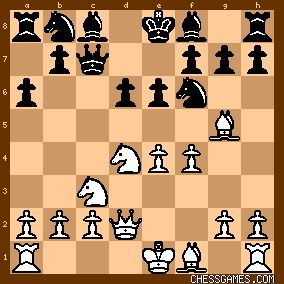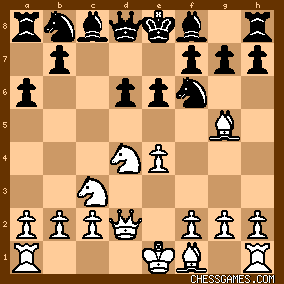| May-02-04 | | chessplayermatthew: why dose 6 Bg5 e6 better then 6 ... e5? |
|
| May-02-04 | | BiLL RobeRTiE: 6...e5? cedes control of d5 with little compensation, i.e. 7. Bxf6 Qxf6 8. Nd5 or 7. Bxf6 gxf6 and White is significantly better. |
|
| Jan-20-05 | | refutor: will anyone else ever champion polugayevsky's 7. ...b5!? i think it might be a good try for a surprise weapon |
|
| Feb-09-05 | | akashic: I ran it on Fritz, black apparently gets a slightly better game after 8. e5. |
|
| Feb-09-05 | | BiLL RobeRTiE: Perhaps that's why 8. Qe2 is considered the best move (8. e5 dxe5 9. fxe5 Qc7 10. exf6 Qe5+ should offer little for White). Any thoughts 7...b5 in general? |
|
| Feb-15-06 | | reekingskunk: it's not possible to do a position search on it if you're not a member...could a member link to position search for the polugaevsky variation? that would be very helpful |
|
| Apr-02-06 | | Dr. Funkenstein: Just to give white players more ammo, 6. ...e5? allows 7. Nf5! and the pressure just keeps building on Black since white will castle queenside. Black can only play e5 after white plays f5 when the knight can no longer jump to f5. In the Be2 variation, Black can allow Nf5 because he can then play d5 followed by d4 with the bishop blocking the e file. I actually was posting because I had a question about the Danner variation. 1. e4 c5 2. Nf3 d6 3. d4 cxd4 4. Nxd4 Nf6 5. Nc3 a6 6. Bg5 e6 7. f4 Be7 8. Qf3 Qa5!? 9. 0-0-0 Bd7 then usually ...Nc6 followed by a knight retreat to b3 which allows black an easier time of playing h6 and g5. Normally 8. ...Qc7 is played followed by 9. 0-0-0 and 10. g4 My question is what if white goes ahead with his usual threat of g4 and h4? Does black have tricks based on a double attack with e5. It seems to me though this is a little hollow and white can just get on with blowing black off the board. I'd love to hear some thoughts by better players than a patzer like myself. |
|
| Apr-13-06 | | suenteus po 147: Just finished a game against <WannaBe> where he played the often seen 7...Qc7 and I responded with 8.Qd2, but the only problem is that 8.Qd2 is not in the database. What gives? Is it an opening blunder? Does it fall into a trap? |
|
Apr-13-06
 | | Open Defence: <suenteus po> I believe 8Qd2 does not sufficiently pressure the central files in the manner that Qf3 does .. hence Black can manage to equalize and probably even maintain a slight edge.. I do not believe it is a blunder losing any material .. the stronger analysts and those with Chess engines could probably take this further |
|
| Apr-13-06 | | AdrianP: Link to Polugaevsky variation:
http://www.chessgames.com/perl/ches...
|
|
| Apr-13-06 | | suenteus po 147: <Open Defence> Thank you, that is instructive. <AdrianP> Any reason you are highlighting the Polugaevsky variation? |
|
| Apr-13-06 | | AdrianP: <sp147> ...someone asked for a link to it above. |
|
| Apr-13-06 | | suenteus po 147: <AdrianP> Oh, sorry. I didn't see it because it was two months ago. lol |
|
| Jan-27-07 | | positionalgenius: I have been playing this opening more often to increase my tactical skills,with mixed results. |
|
Jan-27-07
 | | WannaBe: I usually play 7...Nbd7 in this case. But please keep in mind, the line is still very much transposable, and in theory. "That's all I have to say about that." -- F. Gump |
|
| Dec-30-07 | | KingG: <suenteus po 147> <Just finished a game against <WannaBe> where he played the often seen 7...Qc7 and I responded with 8.Qd2, but the only problem is that 8.Qd2 is not in the database. What gives? Is it an opening blunder? Does it fall into a trap?>

click for larger viewIn addition to what has already been said, i'd like to add that Qd2 is usually not a good idea in the 6.Bg5 Najorf, because it often runs into tricks based on ...Nxe4. For example, in this case Black could play 8...Be7, and now after the plausible 9.0-0-0, comes 9...h6 with the threat of 10.Bh4? Nxe4!. And if 10.Bxf6, then Black gains the two bishops. I'm not sure if this is the best continuation, but it's a possibility. The most common form of this tactic is possibly after the moves 1.e4 c5 2.Nf3 d6 3.d4 cxd4 4.Nxd4 Nf6 5.Nc3 a6 6.Bg5 e6 7.Qd2?!, which i've had a few times in blitz.

click for larger viewBlack then plays 7...h6!, which leaves White with the choices of 8.Bh4? Nxe4!, and Black wins an important central pawn. 8.Bxf6 Bxf6, and Black has the two bishops.
8.Be3 Ng4!, and again Black has the two bishops. |
|
| Dec-31-07 | | suenteus po 147: <KingG> Thanks for those instructive little examples. I think you have some typos in your notation, but I get your meaning loud and clear :) |
|
| Dec-31-07 | | KingG: <suenteus po 147> You're right, I guess it should have been 8.Bxf6 Qxf6. :-) |
|





